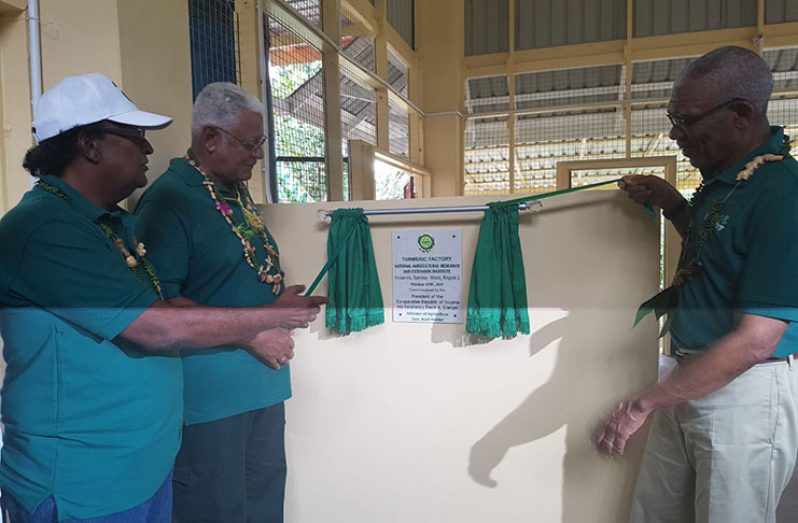–locally grown, processed turmeric from Hosororo
AS early as next month, locally processed turmeric will be available in supermarkets across the country.
This is following the commissioning on Sunday of the National Agricultural Research and Extension Institute (NAREI)’s multi-million-dollar turmeric factory at Hosororo, in Region One (Barima-Waini).
In attendance were President David Granger; Minister of Agriculture, Mr Noel Holder; Minister of Indigenous Peoples Affairs, Mr Sydney Allicock; Region One Chairman, Mr Brentnol Ashley and NAREI’s Dr. Oudho Homenauth.
With the opening of the factory, Guyana will now be able to process turmeric in commercial quantities, thereby incurring a savings of close to US$400,000 which is what it currently costs annually to import the product.
The factory will see NAREI purchasing raw turmeric from local farmers and processing it, then putting it on the local market.
Once it would have fully satisfied the demand on the local market, the Institute says, it will be looking to export processed turmeric by 2019, thereby increasing the country’s foreign export earnings.
Currently, there are 50 acres of turmeric being cultivated by 30 farmers in Region One, but the acreage will have to be increased by 150 to satisfy the local demand.
Dr. Homenauth, in his address, told the gathering that the turmeric factory is one of the transformative projects that his agency is undertaking.
“It means all the money will remain here for the development of the people in this region, and the region in general,” he told his audience at the commissioning ceremony on Sunday.
The facility has the capacity to process a tonne of turmeric every three to four days, an exercise that involves boiling and drying.
GOING SOLAR
But according to Dr. Homenauth, NAREI will be looking to speed up the process a bit by going solar by as early as January, which would allow them to do the same volume they are presently doing in two rather than for days.
Such news was no doubt sweet music to President Granger’s ears, strong advocate that he is of “green” energy. As Dr. Homenauth said, the factory is currently being run on diesel and wood.

Recalling what conditions were like when the Institute first embarked on the project, Dr.
Homenauth said:
“We started with a few kilos of planting materials. It was difficult to import, because you don’t get these materials easily, but with dedication by the relevant staff of the Institute, we were able to increase the planting material.”
Those materials, he said, were then donated to the farmers. And, with the help of the Ministry of Agriculture, through its capital programme, NAREI was able, within a few short years, to “pump up” their own stock.
Back then, he recalled, all he and his staffers wanted was to ensure that they were on the right track, and as such, samples of the dried and polished turmeric were tested both locally and internationally. Turns out, they were!
“We were very happy when the results came back,” he said. “Even the large companies that imported turmeric said the flavour, texture and colour matched those that were imported. And that was one of the reasons why we continued.”
NONE TOO HAPPY
But while NAREI was ecstatic about the way things were turning out, the farmers were not; particularly about the way the processing was done. And that is how the Institute came to acquire the processing facility, so as to make things a little easier, and faster.
“The traditional method was being used, where you had to boil the raw turmeric that you harvest, then you sundried it. And this usually takes three or more days,” Dr Homenauth explained. “You must have continuous sun. And if there is an issue with the weather, then you will have problems.”
As the Regional Chairman explained, agriculture is very important to the development of the region, and as such he commended NAREI for giving the farmers there a break, thereby enabling them to boost the economy of their respective villages.
“They [NAREI] purchased the turmeric from farmers, and then redistributed it to other farmers who may not have been able to purchase their own turmeric to begin their turmeric farming,” Mr Ashley told the gathering.
Back then, he said, which was in 2015, Hosororo was abuzz with excitement as to when the factory will be opened.
“We had several discussions with the engineer and Dr. Homenauth on the importance of this processing plant, which will also provide employment,” he recalled.
And now that it finally has, he urged those villagers who will be working at the facility to take good care of it, and ensure that it is operational at all times as he is hoping that the region can once again become “the bread basket” of the country.


.jpg)











